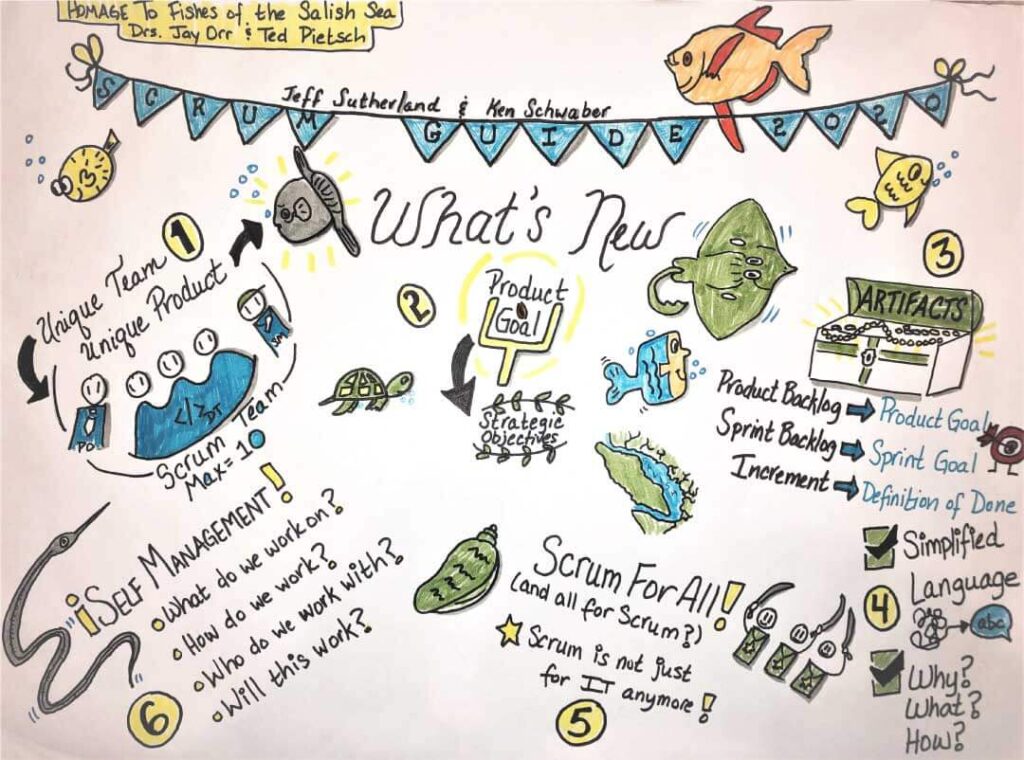Scrum Guide: The Past, Present and Future of Scrum-EN

Miquel Rodríguez
- Business Agility
- Article
Since the release of the new Scrum Guide late last year, there have been numerous articles analyzing the latest Scrum guide. We want to look at it from another perspective. Let’s see where it comes from, and then we’ll do a “Scrum-fiction” exercise to try and predict where it’s going and what the future of Scrum will be.
It’s unbelievable that it has been four years since we first shared our article on the Scrum Guide’s July 2016 update. Recently, the updated 2020 Scrum Guide was released, and social networks have overflowed with interesting articles analyzing the latest changes, word-by-word, and how Scrum has been affected.

Even though the authors the Scrum Guide insist that “Scrum has not changed; we have simply found a better way to explain it.” However, we believe that what has really evolved is a team’s ability to self-organize and self-manage better when applying Scrum. And, through feedback, Scrum itself is also better organized and better managed. Thousands of teams around the world are adopting, with varying success and discipline, Scrum as a framework.
Nearly ten years ago, Steve Danning wrote in Forbes, “If there was a Nobel Prize for management, and if there was any justice in the world, I believe that the prize would be awarded, among others, to Jeff Sutherland, Ken Schwaber and Mike Cohn for their contributions to the invention of Scrum.” The current VUCA climate (volatility, uncertainty, complexity, ambiguity) has forced organizations to rethink their management methods, to plan in the short term, to better visualize the outcome of their work, and to validate the value of their outcomes. By facing this challenge, Scrum has emerged as the most valuable option, and almost always the go-to framework.
The Past
Scrum’s long history began 25 years ago when the Scrum framework was officially presented at OOSPLA 1995. Since then, Scrum has evolved – a lot. On the one hand, there was a logical progression towards using the Scrum in different environments, which generated findings that, in turn, became part of the model. There have also been changes in the elements of Scrum (sprint release planning was added, removed, added again; user stories, the daily stand-up, burndowns, sprint backlog, estimates, etc.). There are even elements that over time have ceased to be part of the official description, even though many teams continue to apply them.
In 2010, Scrum was formalized through the first Official Guide. This was a concise document which unified visions that had begun to diverge and saturated the framework with more and more elements and entities, despite the fact that Scrum was originally designed as a “light” framework.
The Scrum Guide editions: since 2010 there have been seven editions of the Scrum Guide (2010, July 2011, October 2011, 2013, 2016, 2017, and 2020). The new editions are posted on Schwaber and Sutherland’s official website, ScrumGuides.org.
The Present
This first guide was 21 pages long; the 2020 edition is only 14. Reviewing the previous editions, we can clearly see how they boiled it down, and not only in the number of pages:
- Less prescriptive. For example: the three famous “Daily Stand-Up” questions have disappeared, there is only a maximum time duration for each meeting (except the Daily), and no precise indications or examples are given as to what to do in certain cases.
- Clearer. There is simultaneously better clarity in the remaining definitions while also setting very distinct minimums. That way, this flexibility doesn’t give way to labelling anything and everything as “Scrum”.
- Not just a sequence of actions. Instead, each edition leaned more and more heavily on a philosophy and background in the form of pillars, values (beginning in 2016), and a significant influence from Lean.
- More oriented towards value. In fact, value has progressively gained prominence as a central concept in the general evolution of the agile philosophy.
- Less differentiation in the definition of people’s functions. Roles have become functions or accountabilities, and there is only one team. It breaks the tendency to turn roles into differentiated jobs.
- Elegance. This is perhaps the hardest thing to define. Especially in the last edition, they attempted to create a simple and self-replicating structure: the three roles or accountabilities (Product Owner, Scrum Master, and Developer) for the three commitments (Product Goal, Sprint Goal, and Definition of Done) to the three artifacts (Product Backlog, Sprint Backlog, and Increment).
- More academic. This is closely related to the “elegance”. Over time, tips, metaphors, images, and concrete examples have been removed. Because of this, it has become more of a paper that establishes principles rather than an application guide.
- Generalization. It has progressively left behind the world of software where it was born and instead reflects the current reality where Scrum is applied in almost any type of activity and circumstance. There is a caveat to this though: when it becomes a kind of default practice, you don’t always see whether or not it’s the most appropriate in each case.
Check out this fun illustration that my co-worker, Ali, drew to visually show the updates in the new version.

The Future
Now that we’ve seen the path that Scrum has traveled so far, I want to hypothesize what I think Scrum will be like in 5, 10, and even 15 years. I’ll start with the clearest trends, and as we move forward, I’ll be more speculative:
- It will lose all mention of software development, instead becoming a framework for agile teams, regardless of the type of work they perform.
- It will never evolve towards scaling; each author defends their own framework, and Scrum is a neutral terrain set forever in teams.
- It will have even less differentiation of the different functions to be shared by the whole team.
- It has gone as far as it can with eliminating content and prescriptiveness. At some point, they could start adding them in again. The opposite could happen with illustrations and examples; the first papers had diagrams and illustrations, and in the latest versions, no visual components were included.
- Scrum will be “Kanbanized”, and Kanban will be “Scrummified”, but they will never be one and the same. Each one will maintain its own naming conventions and distinctive elements to distinguish them as different things.
- Ken Schwaber and Jeff Sutherland will relinquish responsibility for maintaining the official version of the Scrum Guide to a small group of people. But the community will cling to the last version updated by the two founders, thus cutting off official evolution.
- New frameworks will emerge that combine Scrum, Kanban, and other elements for specific industries (e.g., software product development, marketing, innovation, etc.), gradually replacing Scrum in terms of relevance.
Until all of this happens (or not – I could be wrong!), Scrum will remain the compass that teams use to guide themselves in designing their way of working and organizing. Deepening your understanding and good application of Scrum will be key to achieving good results. We look forward to helping you along the way!
— Miquel (and Alonso)

Are you ready for the future of Scrum?
We can help you adopt the Scrum Framework and perfect its application in your organization.
